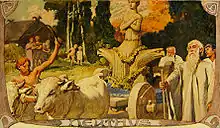Germanic mythology
Germanic mythology consists of the body of myths native to the Germanic peoples. The category includes Norse mythology, Anglo-Saxon mythology, and Continental Germanic mythology.[1][2][3] It was a key element of Germanic paganism. These stories establish the creation and creature myths that permeated Northern European cultures. They are concerned with the deities, mythical creatures, places and customs that shaped the early and proceeding Germanic peoples.
| Mythology |
|---|
| See also |
| List of mythologies |

Origins
As the Germanic languages developed from Proto-Indo-European language, Germanic mythology is ultimately a development of Proto-Indo-European religion. Archaeological remains, such as petroglyphs in Scandinavia, suggest continuity in Germanic mythology since at least the Nordic Bronze Age.[1][2]
Sources
The earliest written sources on Germanic mythology include literature by Roman writers. This includes Commentaries on the Gallic War by Julius Caesar, Geographica by Strabo, and Germania by Tacitus.[1] Later Latin-language sources on Germanic mythology include Getica by Jordanes, History of the Lombards by Paul the Deacon, Ecclesiastical History of the English People by Bede, Vita Ansgari by Rimbert, Gesta Hammaburgensis ecclesiae pontificum by Adam of Bremen, and Gesta Danorum by Saxo Grammaticus.[1]
Vernacular sources on Germanic mythology include the Merseburg Charms, the Nibelungenlied,[2] and various pieces of Old English literature, particularly Beowulf.[1] The most important sources on Germanic mythology are however works of Old Norse literature, most of whom were written down in the Icelandic Commonwealth during the Middle Ages. Of particular importance is the Poetic Edda.[1]
Archaeological evidence, Runic inscriptions and place-names are also useful sources on Germanic mythology.[1]
Mythology
Commonly featuring narratives focused on Germanic deities and a large variety of other entities.
Cosmology
The beginning and end of the world is told in Völuspá, the first and best known poem in the Poetic Edda. As told by the seeress in Völuspá, the world began with a great magical nothingness called Ginnungagap. From the sea Odin and his two brothers emerged, and came across Ask and Embla, whom they created into the first human couple.[1]
The accounts of Völuspá are contrasted with those in Vafþrúðnismál and Grímnismál. These say that Odin created the world from the body of the giant Ymir. Odin and his brothers were in turn descended from Búri, who had been created by the primeval cow Auðumbla. Parallels to Auðumbla are found in Indo-Iranian religion, testifying to the ancient Indo-European origins of Germanic mythology.[1]
A central point in the Germanic cosmos is the tree Yggdrasil.[3] Germanic mythology prophetizes the end of the world in a coming Ragnarök.[1]
Deities
A number of Germanic gods are mentioned in Old Norse literature. These are divided into the Æsir and the Vanir. The Æsir are primarily gods of war and dominate the latter, who are gods of fertility and wealth.[1]
The chief god of the Æsir was Odin, who is the god of war and wisdom. He was probably worshiped primarily by kings and noblemen rather than the common people. Odin was the lord of Asgard, the abode of the gods. Asgard included the majestic hall Valhalla, where warriors who had died a heroic death in battle (Einherjar) were admitted in order to prepare them to help Odin in the coming Ragnarök.[1]
Odin's son Thor by his wife Frigg, was the god of thunder. Wielding his hammer Mjölnir, Thor was engaged in conflict with the jötnar (giants) and the serpent Jörmungandr. Thor has many parallels in Indo-European mythology. He appears to have been worshiped extensively by the Germanic peoples, particularly warriors and the common people. A notable brother of Thor is Baldr. Other significant Æsir include the trickster god Loki; Heimdallr, who is reported in Rígsþula to have fathered the three classes of men; and the god of war Týr, who appears to have preceded Odin as the chief deity in the Germanic pantheon.[1]
In Old Norse literature the Æsir and Vanir are described as being in conflict. Through this conflict, certain Vanir gods, such as Njörðr, Freyja, Freyr, are recorded as having joined the Æsir.[1] Similarities have been pointed out between Njörðr and Nerthus, a Germanic fertility god mentioned by Tacitus in Germania in the 1st-century AD.[1] Sources also mention numerous other entities, such as Hel, who oversees an underworld location of the same name.[3]
Legacy
During the Middle Ages, Germanic peoples were converted to Christianity. The study of Germanic mythology has remained an important element of Germanic philology since the development of the field and the topic is an integral component of Heathenry, the modern revival of Germanic paganism. Elements of Germanic mythology has survived into modern Germanic folklore.
See also
References
- Turville-Petre, E. O. G.; Polomé, Edgar Charles. "Germanic Religion And Mythology". Encyclopædia Britannica Online. Retrieved January 3, 2020.
- Polomé, Edgar Charles; Fee, Christopher R.; Leeming, David Adams (2006). "Germanic mythology". In Leeming, David Adams (ed.). The Oxford Companion to World Mythology. Oxford University Press. ISBN 9780199916481. Retrieved January 3, 2020.
- "Teutonic mythology". World Encyclopedia. Philip's. 2006. ISBN 9780199546091. Retrieved January 3, 2020.
Further reading
- Bauschatz, Paul C. (1982). The Well and the Tree: World and Time in Early Germanic Culture. New York: University of Massachusetts Press.
- Hasenfratz, Hans-Peter (2011). Barbarian Rites: The Spiritual World of the Vikings and the Germanic Tribes. Simon and Schuster. ISBN 9781620554487.
- Turville-Petre, Gabriel (1975). Myth and Religion of the North: The Religion of Ancient Scandinavia. Holt, Rinehart and Winston.
